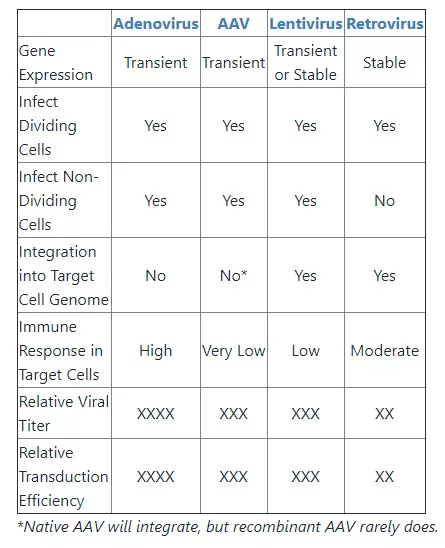
Viral Systems
Virus-based Expression Systems
Efficient Gene Delivery
Recombinant viruses are excellent tools for the introduction of genetic material into host cells. Each virus differs in how it infects cells and replicates:
- Lentiviruses (e.g. HIV-1, FIV, SIV) are a sub-class of retroviruses that can be used for both transient and stable gene expression; they can infect both proliferating and non-proliferating cells.
- Retroviruses (e.g. MMLV) introduce genetic material into the genome of the host cell, allowing long-term stable expression. Retroviral titer is typically lower than that of adenovirus.
- Adenoviruses can infect a variety of mammalian cell types with high efficiency. They remain epichromosal upon infection, so they are only suitable for transient expression.
- Adeno-Associated Virus (AAV) integrates into the host cell genome at a very specific site in one human chromosome; random insertions are very rare, making it less immunogenic than adenovirus or retrovirus.
Select your Recombinant Virus for Gene Delivery

In summary:
- Lentivirus has become a popular choice since it provides some advantages of both adenovirus and retrovirus. Generally higher titers are possible with lentivirus compared to retrovirus, and lentivirus can provide both transient and stable gene expression. It also elicits a lower immune response than adenovirus.
- MMLV-based retrovirus is ideal for generating stable expression of your gene in the target cell, since it easily integrates into the cell genome and stable cells are easily selected. However, retrovirus is usually produced at relatively low titers, and it can be more difficult to get into a target cell.
- Adenovirus is usually produced in the highest titer and is typically the easiest to penetrate the target cell. It is also the only virus that can be amplified without re-packaging new virus. However, adenovirus only provides transient gene expression, since the gene will not incorporate into the target cell's genome. Also, adenovirus tends to elicit the highest immune response of all four viruses; this can be a problem when targeting very sensitive cells such as primary cells.
- AAV has become a popular choice due to its extremely low immune response and the variety of serotypes available. Each AAV serotype has varying infectivity rates in different types of target cells, so you can choose the serotype that is best for your specific cell rather than having to choose a one-size-fits-all approach.
Tools provided for your Viral Expression Studies
- Viral Packaging Systems
- Cell Lines designed for superior viral expression
- Premade Gene-Specific Viruses and Plasmids
- Virus Concentration and Purification Kits
- Viral Titer/Quantitation Kits
- Viral Transduction Reagents